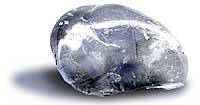Navigation and the “sunstone”
Monday, March 5, 2007, 7 comments
 A report from Lund University lends a certain credibility to the old myth about the viking´s “sunstone” – a navigational aid, using polarized light to “see” the sun on cludy or foggy days.
A report from Lund University lends a certain credibility to the old myth about the viking´s “sunstone” – a navigational aid, using polarized light to “see” the sun on cludy or foggy days.
The work, published in the latest edition of Proceedings of the Royal Society A, is a joint venture with biologists and physicists. Susanna Åkesson, works with birds and tortoises navigation, believes that these have special receptors in their eyes, and can se pattern of polarized light in the sky. The hungarian optician Gábor Horváth have developed a photogtaphic method to study these polarized patterns. Together they had the means of studying the possibility of polarization aided navigation.
The islandic tales mentiones a sunstone as a navigational id, but no such stone have ever been found. In the 1960:s Torkild Ramskou proposed that the sunstone may have been a polarizing crystal - calcit, turmelin or cordierit, mineral found on Iceland – that enabled them to “see” the sun through heavy clouds or fog. The theory was widely doubted, with no actual stones found and no experimental support.
But the recent report show that it is possible to get accurate data on the sun in those conditions with that kind of crystals.
Apart from these stones the vikings used simple sun compasses – wooden plates with pegs. Such a contraption can be used to show time if the direction is known and direction if time is known. Every seagoing civilization knows that the sun peaks at noon, which means that at least once a day they have a time fix. And the sun altitude gives information on the viewers latitude. To find Iceland they could sail north along the norwegiwen west coast until they reached lat 65 N, then west along the same height to Iceland, then from south Iceland along lat 60 N to Greenland and the north of Labrador.
That wes the easy part. The longitude was quite another matter. It was not solved until Harrisons chronometer in the mid 18th century – decribed interestingly in “Longitude” by Dava Sobel while Umberto Eco´s “The Island of the Day Before” focus on some of the less scientific methods tried.

